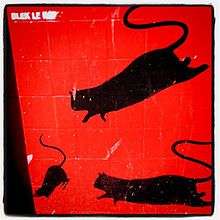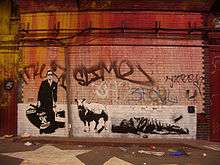Blek le Rat
.jpg)
Blek le Rat (pronounced: [blɛk lə ʁa]; born Xavier Prou,[1] 1952)[2] was one of the first graffiti artists in Paris, and has been described as the "Father of stencil graffiti".[3]
Early life
Xavier Prou was born on 15 November 1951 in Boulogne-Billancourt in the western suburbs of Paris.
Early career and influence


Blek began his artwork in 1981, painting stencils of rats on the walls of Paris streets. He described the rat as "the only free animal in the city",[4] and one which "spreads the plague everywhere, just like street art".[5] His name originates from the comic book Blek le Roc, using "rat" as an anagram for "art".[3]
Initially influenced by the early graffiti-art of New York City after a visit in 1971, he chose a style which he felt better suited Paris, due to the differing architecture of the two cities.[4] He also recognised the influence of Canadian artist Richard Hambleton, who painted large-scale human figures in the 1980s.[3] In 1985, he was on the first meeting of the graffiti and urban art movement in Bondy (France), on the VLP's initiative, with Speedy Graphito, Miss Tic, SP 38, Epsylon Point, Jef Aérosol, Futura 2000, Nuklé-Art, Banlieue-Banlieue. Although Blek is sometimes described as the first to transform stencil from basic lettering into pictorial art,[1] this claim is factually incorrect—Chaz Bojorquez was actually creating stencil graffiti in the United States as early as 1969,[6] two years before Blek's 1971 trip to New York and more than a decade before Blek settled on "his" stencil technique. Blek's oldest preserved street art graffito, a 1991 replica of Caravaggio's Madonna di Loreta, which he dedicated to his future wife Sybille, was rediscovered behind posters on a house wall in Leipzig, Germany, in 2012.[7]
French authorities identified Blek in 1991 when he was arrested while stencilling a replica of Caravaggio's Madonna and Child, with the connection to Blek and his artwork being made by police. From that point on, he has worked exclusively with pre-stenciled posters, citing the speedier application of the medium to walls, as well as lessened punishment should he be caught in the act.[1]
He has had a great influence on today's graffiti-art and "guerilla-art" movements, the main motivation of his work being social consciousness and the desire to bring art to the people. Many of his pieces are pictorials of solitary individuals in opposition to larger, oppressive groups.[5] In 2006 he began his series of images representing the homeless, which depict them standing, sitting, or lying on sidewalks, in attempts to bring attention to what he views as a global problem.[8]
Influence on and opinion of Banksy
British graffiti artist Banksy has acknowledged Blek's influence stating "every time I think I've painted something slightly original, I find out that Blek Le Rat has done it as well, only twenty years earlier."[9] The two have expressed mutual desire for collaboration; in 2011, Blek was seen adding to a mural begun the previous year by Banksy in the Mission District, San Francisco.[10]
Blek le rat initially disagreed with those who claim Banksy has copied his work: "People say he copies me, but I don't think so. I'm the old man, he's the new kid, and if I'm an inspiration to an artist that good, I love it. I feel what he is doing in London is similar to the rock movement in the Sixties."[9] More recently, however, in the documentary Graffiti Wars, Blek took a different tone, stating, "When I see Banksy making a man with a child or Banksy making rats, of course I see immediately where he takes the idea. I do feel angry. When you're an artist you use your own techniques. It's difficult to find a technique and style in art so when you have a style and you see someone else is taking it and reproducing it, you don't like that. I'm not sure about his integrity. Maybe he has to show his face now and show what kind of guy he is."[11] However, Blek's complaint that Banksy copied his "technique and style" is seriously undermined by the fact that massively influential street art pioneer Chaz Bojórquez[12] was actually creating pictorial stencil graffiti in the late 1960s,[6] long before Blek himself had adopted that technique and style.
Exhibitions
.jpg)

In October 2006, Blek le Rat had his first solo U.K. exhibition in London at the Leonard Street Gallery. He participated in the Cans Festival in 2008, which featured outdoor street stencil painting in Waterloo, London by many of street art's biggest names.[9]
His American gallery debut took place at Subliminal Projects Gallery in Los Angeles in 2008. It included paintings, silkscreen, and three-dimensional artwork, as well as photography from his wife, Sybille Prou.[3]
Blek also had an exhibition in December 2009 at the Metro Gallery in Melbourne, a centre of street art in Australia. The exhibition entitled "Le Ciel Est Bleu, La Vie Est Belle" (The sky is blue, life is beautiful), featured wooden panels, canvas, screen-print, and photographs, tracing the artist's oeuvre from the early 1980s to the present.
Blek le Rat has nonetheless expressed preference for the streets over galleries, stating the integrity of an artist is to be seen by as many people as possible, not being sold or recognized in a museum.[4]
In 2014, Blek le Rat exhibited 3 large-scale original paintings and an edition of 25 unique monotypes with lithography[13] in a setting that bridges these traditional spaces — the Quin hotel in New York City — as part of the hotel’s Quin Arts program. The artist created the lithographs at the New York Academy of Art during his tenure as artist in residence at the Quin hotel. Collectively entitled "Escaping Paris," the exhibit was curated by DK Johnston of The Arts Fund. The Quin’s permanent collection also includes Blek le Rat’s “Love America” on the 14th floor and loaned works the “Great Wedding” on the second floor, “What Has Been Seen Cannot Be Unseen” in the boardroom, and “Tango” in the lobby. Most recently, Blek le Rat commemorated this collaboration on the Quin’s façade with an image of Andy Warhol.[14]
See also
References
- 1 2 3 Januszczak, Waldemar (8 June 2008). "Blek le Rat, the man who gave birth to Banksy". London: The Sunday Times. Retrieved 26 April 2010.
- ↑ "Blek le Rat: This is not a Banksy". London: The Independent. 19 April 2008. Retrieved 21 May 2008.
- 1 2 3 4 Gilewicz, Samantha (4 April 2008). "The insider: blek le rat". Nylonmag.com. Retrieved 29 March 2011.
- 1 2 3 Reiss, Jon. Blek le Rat. Swindle, Issue 11. Retrieved 28 March 2011.
- 1 2 Blek Le Rat interview Archived 18 April 2011 at the Wayback Machine.. UK Street Art. 29 July 2008. Retrieved 29 March 2011.
- 1 2 Vuong, Katherine (22 November 2015). "Chaz Bojorquez". Calligraffiti. Los Angeles. Retrieved 22 November 2015.
- ↑ Wall piece by street artist Blek Le Rat saved in Leipzig. Artsation. 15 April 2013. Retrieved 20 June 2013.
- ↑ Soteriou, Helen (4 January 2010). "Exclusive Interview: Blek le Rat on Homelessness". Juxtapoz.com. Retrieved 4 November 2011.
- 1 2 3 Coan, Lee (13 June 2008). "Breaking the Banksy: The first interview with the world's most elusive artists". Daily Mail. London.
- ↑ Wong, Vic (17 March 2011). "Blek le Rat meets Banksy in the Mission". Missionmission.org. Retrieved 29 March 2011.
- ↑ Sanderson, Elizabeth (13 August 2011). "Banquesy: The Frenchman – known as Blek le Rat – accusing Banky of stealing his 'guerilla art' style". Daily Mail. London. Retrieved 15 August 2011.
- ↑ Finkel, Jori (9 April 2011). "L.A.'s street art pioneers paint a colorful history". Los Angeles Times. Los Angeles. Retrieved 9 April 2011.
- ↑ Robehmed, Natalie (20 October 2014). "Forget Banksy: Meet Blek Le Rat, The Father Of Stencil Graffiti". Forbes. Forbes. Retrieved 27 October 2014.
- ↑ "Quin Arts, Artist in Residence: Blek le Rat". theQuinhotel.com. Retrieved 27 October 2014.
Further reading
- Blek le Rat – Getting Through the Walls by Sybille Prou and King Adz. Thames & Hudson (2008). ISBN 978-0-500-28735-4
- "BLEK LE RAT – 30 Years. Art Publishing Limited. (2011) Essays by Jonathan LeVine, Jonathan LeVine Gallery, Jeffrey T. Iverson, Time Magazine, Carol Kino, culture critic, journalist, and regular contributor to the New York Times, Russell Howze, author of "Stencil Nation: Graffiti, Community, and Art, Carolo McCormick, culture critic, curator and senior editor of Paper Magazine, Waldemar Januszczak, Britain’s most distinguished art critic, writer for Sunday Times, Jean-David Malat, Opera Gallery, Justin Giarla, White Walls Gallery, Anthony Lister, painter and installation artist, Shepard Fairey, street artist, Adam Rozan, Writer.[1]
External links
| Wikimedia Commons has media related to Blek le Rat. |
- Official website
- 2013 Interview, Boygirl Magazine
- Curbs and Stoops Interview
- Grafiteros – ElPais.com
- Fecal Face interview (04/2008)
- Canned Goods – Blek Le Rat Interview (September '08)
- "Blek Le Rat" The 30 Year Anniversary Retrospective (2011)
- ↑ "Blek le Rat" The 30 Year Anniversary Retrospective. Art Publishing LTD. p. 156.
